Obukhovo, Noginsky District, Moscow Oblast
Obukhovo (Russian: Обу́хово) is an urban locality (a work settlement) in Noginsky District of Moscow Oblast, Russia, located 26 kilometers (16 mi) east from Moscow. Population: 9,630 (2010 Census);[1] 10,746 (2002 Census);[5] 11,359 (1989 Census).[6]
Obukhovo
Обухово | |
|---|---|
Work settlement | |
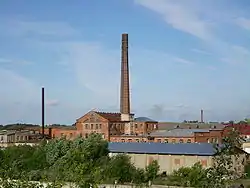 Former Obukhovo Lenin Carpet Factory | |
.png.webp) Flag  Coat of arms | |
Location of Obukhovo 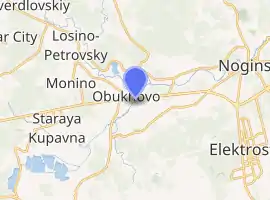
| |
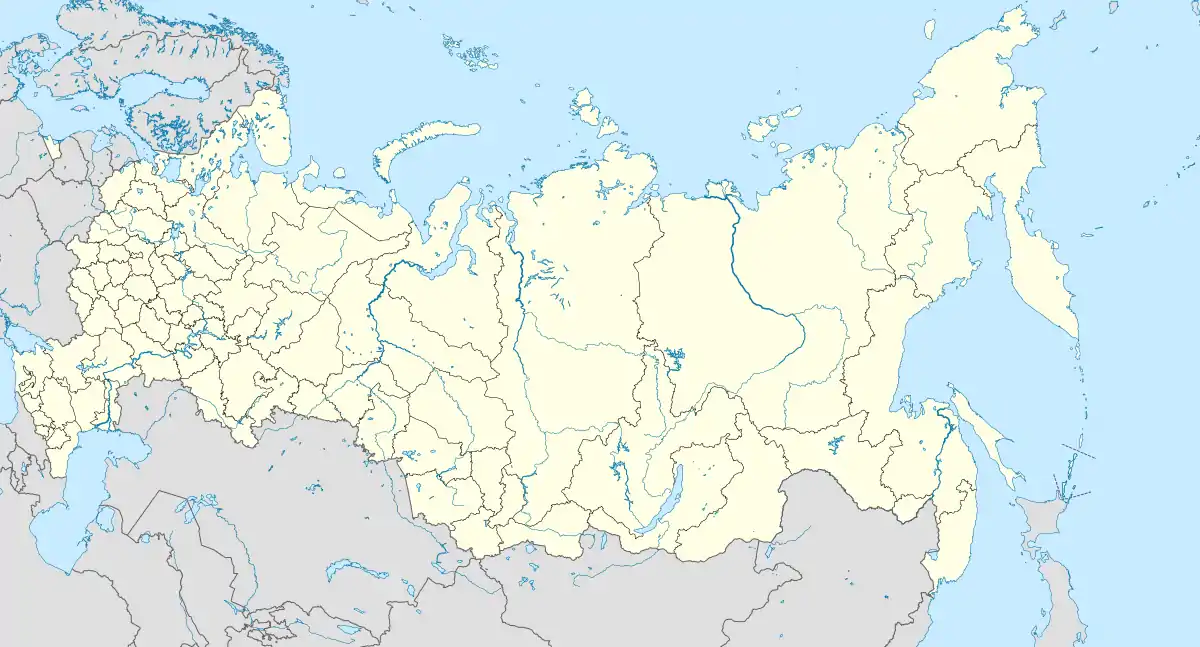 Obukhovo Location of Obukhovo 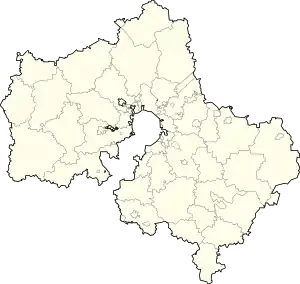 Obukhovo Obukhovo (Moscow Oblast) | |
| Coordinates: 55°49′42″N 38°17′07″E | |
| Country | Russia |
| Federal subject | Moscow Oblast |
| Administrative district | Noginsky District |
| Founded | 1573 |
| Government | |
| • Body | Council of Deputies |
| • Head | Nikolay Sushchenko |
| Elevation | 135 m (443 ft) |
| Population | |
| • Total | 9,630 |
| • Estimate (2018)[2] | 10,003 (+3.9%) |
| • Municipal district | Noginsky Municipal District |
| • Urban settlement | Obukhovo Urban Settlement |
| Time zone | UTC+3 (MSK |
| Postal code(s)[4] | 142440 |
| Dialing code(s) | +7 49651 |
| OKTMO ID | 46639158051 |
| Urban-type settlement Day | One of the Saturdays in August |
| Website | www |
Overview
The settlement is divided into two parts by the M7 auto route.
Two rivers flow through Obukhovo: the Klyazma and the Shalovka (Klyazma's tributary).
Obukhovo used to be a famous center of textile industry. Its core enterprises were a sand pit and two carpet factories. Bankruptcy of the factories led to their closure in 2002.
History
Obukhovo was first mentioned in a book about Moscow region written in 1573–1574. In 1708, English businessman Andrew Stales built a powder mill in Obukhovo, which later manufactured gunpowder. In the first half of the 19th century the powder mill underwent bankruptcy and was sold on auction.
In 1775, Obukhovskaya suburb was organized near the powder mill.
In 1852, Anisim Tyulyaev built a clothing factory and in 1857 Mikhail Brunov built a carpet factory in Obukhovskaya suburb. After the October Revolution, both factories were nationalized. In 1958, the factories merged under the name of "Lenin Carpet and Clothing Enterprise of Obukhovo".
On May 21, 1928, the settlement was granted urban-type settlement status and renamed Obukhovo.
In 2002, "The Carpets of Obukhovo" Joint Stock Company (former "Lenin carpet and cloth combine of Obukhovo") went bankrupt and in 2006 it was liquidated.
Demographics
| Year of census | Population |
|---|---|
| 1775 | 281 |
| 1816 | 390 |
| 1897 | 1,542 |
| 1925 | 3,867 |
| 1929 | 3,905 |
| 1957 | 7,800 |
| 1989 | 11,359[6] |
| 2002 | 10,746[5] |
| 2010 | 9,630[1] |
Sports
The settlement is also well known as one of the bandy centres of Russia. Many players from Obukhovo has become World Champions. Sportivny Klub Obukhovo[7] is the only club outside the highest division of Russian Bandy Super League to have an artificial ice.[8] Obukhovo has hosted several Youth World Championships. In February 2011 it was for Girls-17,[9] in December 2011 for Boys-23, in which the Russian team was victorious after beating Sweden after extra-time in the final[10] and in 2013 the same tournament.[11]
The other sections of Sportivny Klub Obukhovo are association football, volleyball, judo, and field hockey.
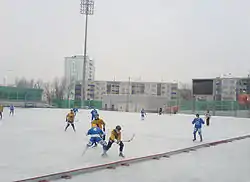
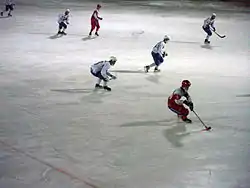
References
- Russian Federal State Statistics Service (2011). "Всероссийская перепись населения 2010 года. Том 1" [2010 All-Russian Population Census, vol. 1]. Всероссийская перепись населения 2010 года [2010 All-Russia Population Census] (in Russian). Federal State Statistics Service.
- "26. Численность постоянного населения Российской Федерации по муниципальным образованиям на 1 января 2018 года". Federal State Statistics Service. Retrieved January 23, 2019.
- "Об исчислении времени". Официальный интернет-портал правовой информации (in Russian). June 3, 2011. Retrieved January 19, 2019.
- Почта России. Информационно-вычислительный центр ОАСУ РПО. (Russian Post). Поиск объектов почтовой связи (Postal Objects Search) (in Russian)
- Russian Federal State Statistics Service (May 21, 2004). "Численность населения России, субъектов Российской Федерации в составе федеральных округов, районов, городских поселений, сельских населённых пунктов – районных центров и сельских населённых пунктов с населением 3 тысячи и более человек" [Population of Russia, Its Federal Districts, Federal Subjects, Districts, Urban Localities, Rural Localities—Administrative Centers, and Rural Localities with Population of Over 3,000] (XLS). Всероссийская перепись населения 2002 года [All-Russia Population Census of 2002] (in Russian).
- "Всесоюзная перепись населения 1989 г. Численность наличного населения союзных и автономных республик, автономных областей и округов, краёв, областей, районов, городских поселений и сёл-райцентров" [All Union Population Census of 1989: Present Population of Union and Autonomous Republics, Autonomous Oblasts and Okrugs, Krais, Oblasts, Districts, Urban Settlements, and Villages Serving as District Administrative Centers]. Всесоюзная перепись населения 1989 года [All-Union Population Census of 1989] (in Russian). Институт демографии Национального исследовательского университета: Высшая школа экономики [Institute of Demography at the National Research University: Higher School of Economics]. 1989 – via Demoscope Weekly.
- Official home page
- "Archived copy". Archived from the original on October 14, 2013. Retrieved August 28, 2013.CS1 maint: archived copy as title (link)